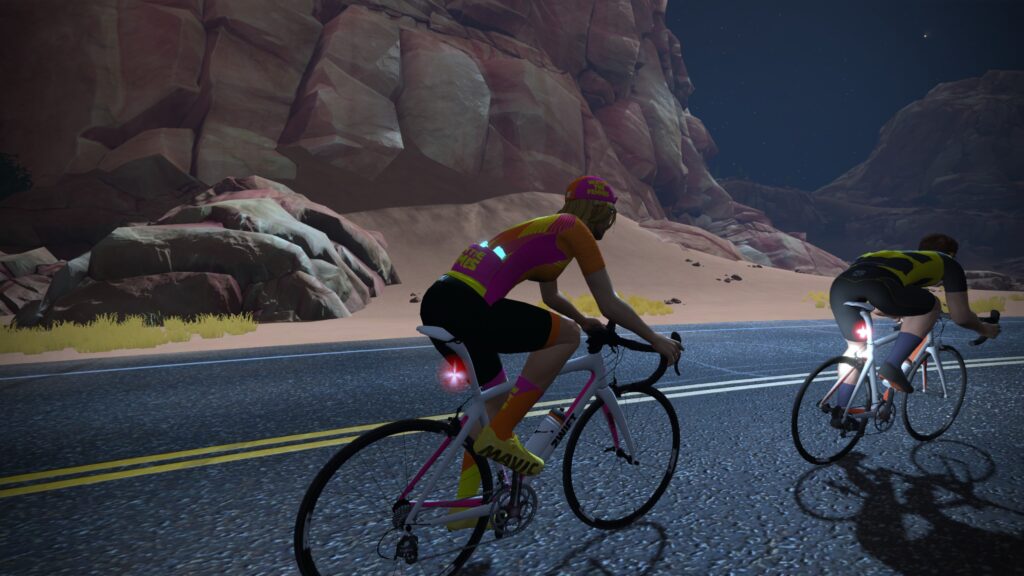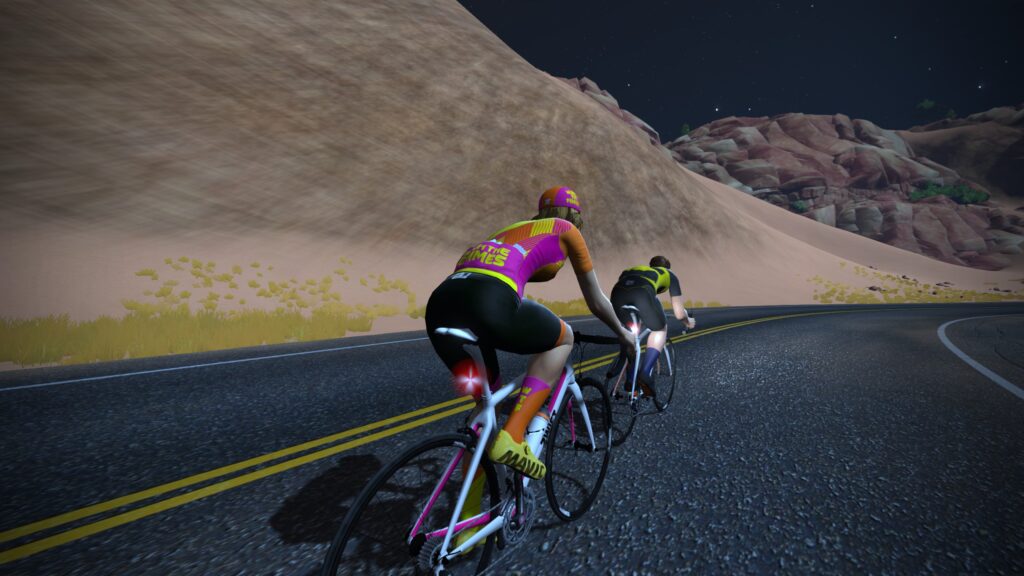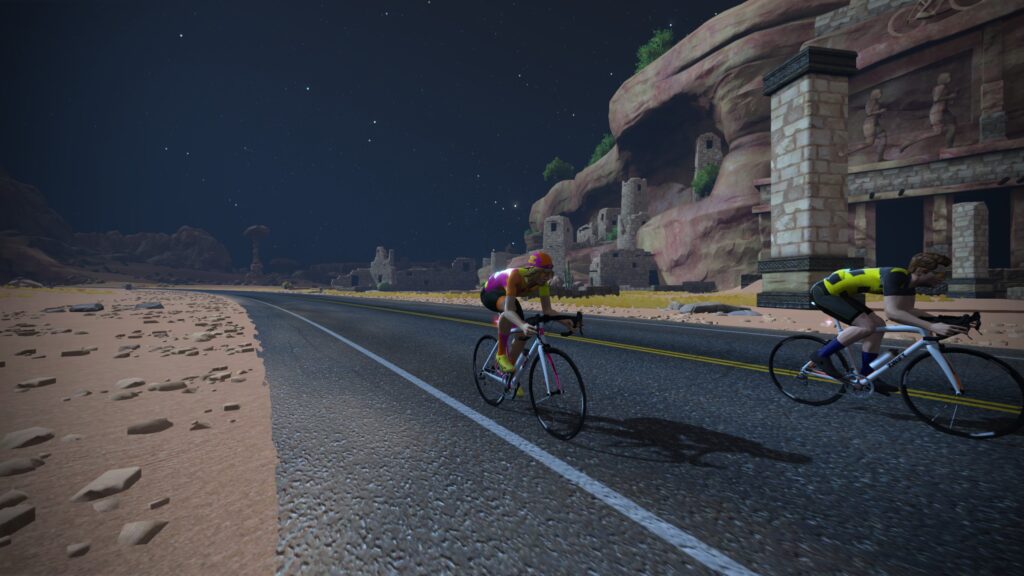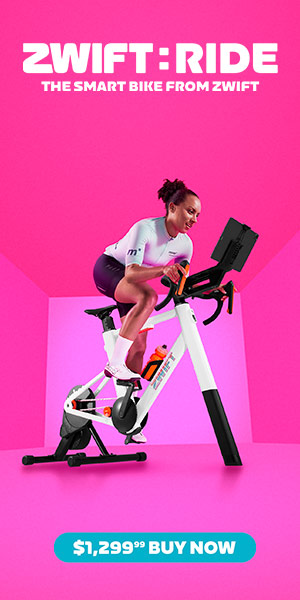There’s been a lot of chatter in the Zwift community since Zwift launched the Play Controllers on June 14. While I still maintain that one of the biggest benefits of Play is the ability to navigate menus, etc using its buttons, a lot of the buzz surrounding Play involves steering.
Specifically, many Zwifters are asking if steering makes you faster, and if so, is it fair to have steering in a race with riders who don’t?
I put together a few tests to get some hard numbers to help answer those questions. For science. Because that’s what we do at Zwift Insider!
Test 1: Crit City Lap Savings (Steering vs Non-Steering)
First, I wanted to compare lap times on a twisty course between two riders: one steering well into the corners, the other not steering at all.
I set my bot to 375W (5W/kg) on Bell Lap because that gave the solo rider a speed of around 46kph on the flats, which is comparable to an A or B race pack in Crit City. (Don’t let the power number confuse you – the important thing here is the rider’s speed and lap times.)
- Lap time without steering: 2:38.9
- Lap times with steering: 2:35.7 and 2:35.4 (I got better the second time around!)
Test 1 Takeaways
This test clearly shows that steering allows you to turn in faster lap times in a solo rider environment such as an iTT. Why? Because taking the inside line on corners effectively makes the overall course shorter for your rider.
That said, this test does exaggerate the time savings you would receive from steering, if you’re looking at the entire universe of Zwift routes. Steering time savings is higher on routes with lots of turns, or to put it another way, your “seconds saved per kilometer” would be lower on straighter routes like Tempus Fugit.
Additionally, in a race you may have to choose between steering to the inside of a corner (out of the draft) and staying in the draft while taking a longer line. In my experience, cutting the corner is still the faster move – but losing the draft does blunt the benefit of taking the shorter line.
Test 2: Draft Positioning on Tempus Fugit
We know that drafting is an important part of Zwift, just as it’s a key part of outdoor riding. But now that we can steer left and right as well as brake, it’s probably work looking at how the draft benefit changes based on your position relative to the rider(s) ahead.
For this test, I set up two bots in an event on Tempus Fugit. The front bot held 300W, while I modulated the power of the back bot to test what sort of wattage I had to hold to stay in the draft at different positions. I included a Sauce for Zwift draft overlay in the video below since it’s a useful point of reference:
In the end, I came away with three useful numbers:
- On the wheel: 212W
- Just off-center (by 1-2′, or 50cm): 240W
- Out of the draft (rider in the drops): 300W
Not surprisingly, I maximized my draft benefit by riding directly behind the front rider. Sitting on the wheel of a 300W rider at 212W means I received a 29.3% power savings. On flat ground, Sauce showed a draft as high as 124W in this position.
Note: Zwift says Sauce’s draft number is the “absolute watts” you’re saving in the draft.
If I moved just a bit off center from the rider’s wheel while staying in the draft, I had to up my power to ~240W to keep up. That means my power savings was 20%. On flat ground, Sauce showed a draft as low as ~40W in this position.
Lastly, if I moved far enough to either side that Sauce showed 0W draft and my rider in the drops (indicating no draft), I had to hold 300W to keep up with the rider ahead. Seems logical.



Test 2 Takeaways
This test clearly shows that left-right positioning greatly affects the draft benefit received on Zwift. When you’re just behind a rider, being just 50cm off to either side reduces your draft effect by ~30W, meaning you’ll need to put out more watts to hold position.
It’s important to note that this finding doesn’t apply only to steering Zwifters! If you aren’t steering in game, Zwift is auto-steering for you. While auto-steering generally does a solid job of placing you in a good position, it doesn’t always place you directly behind the rider(s) ahead. If that happens, you may want to bump up your power a bit to avoid losing position while the game auto-steers you to a better place.
Do steering riders have a drafting advantage since they can dial in their left-right position? Perhaps. But if they do, it’s minimal since the game’s auto-steering does a good job of keeping us in the draft. Consider also that steering brings adds a mental/physical load – you have to pay attention and manipulate your steering device in order to draft optimally. You can steer into the maximum draft, but if you steer poorly you can hurt yourself just as quickly.
Other Play Advantages
Zwift Play offers more advantages than just taking the inside line on corners or positioning yourself for the maximum draft benefit. It also places powerups, a rearview cam, and minimap changes right at your fingertips. And of course, steering lets you veer to the far left or right when attacking off the front, so auto-steering (non-steering) riders can’t grab your wheel. That’s a big deal when it comes to mid-race attacks or the final sprint.
Questions or Comments?
Does Zwift Play offer an advantage to racers? I’m not answering that here… just sharing data and observations. But please share your thoughts below!
